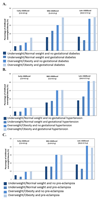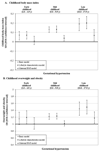Influence of maternal obesity on the association between common pregnancy complications and risk of childhood obesity: an individual participant data meta-analysis
- PMID: 30201470
- PMCID: PMC6196075
- DOI: 10.1016/S2352-4642(18)30273-6
Influence of maternal obesity on the association between common pregnancy complications and risk of childhood obesity: an individual participant data meta-analysis
Abstract
Background: Gestational diabetes and gestational hypertensive disorders are associated with offspring obesity, but the role of maternal adiposity in these associations remains unclear. We aimed to investigate whether these pregnancy complications affect the odds of offspring obesity independently of maternal obesity.
Methods: We did an individual participant data (IPD) meta-analysis of mother-offspring pairs from prospective birth cohort studies that had IPD on mothers with singleton liveborn children born from 1989 onwards and had information available about maternal gestational diabetes, gestational hypertension or pre-eclampsia, and childhood body-mass index (BMI). We applied multilevel mixed-effects models to assess associations of gestational diabetes, gestational hypertension, and pre-eclampsia with BMI SD scores and the odds of overweight and obesity throughout childhood, adjusting for lifestyle characteristics (offspring's sex, maternal age, educational level, ethnicity, parity, and smoking during pregnancy). We then explored the extent to which any association was explained by maternal pre-pregnancy or early-pregnancy BMI.
Findings: 160 757 mother-offspring pairs from 34 European or North American cohorts were analysed. Compared with uncomplicated pregnancies, gestational diabetes was associated with increased odds of overweight or obesity throughout childhood (odds ratio [OR] 1·59 [95% CI 1·36 to 1·86] for early childhood [age 2·0-4·9 years], 1·41 [1·26 to 1·57] for mid childhood [5·0-9·9 years], and 1·32 [0·97 to 1·78] for late childhood [10·0-17·9 years]); however, these associations attenuated towards the null following adjustment for maternal BMI (OR 1·35 [95% CI 1·15 to 1·58] for early childhood, 1·12 [1·00 to 1·25] for mid childhood, and 0·96 [0·71 to 1·31] for late childhood). Likewise, gestational hypertension was associated with increased odds of overweight throughout childhood (OR 1·19 [95% CI 1·01 to 1·39] for early childhood, 1·23 [1·15 to 1·32] for mid childhood, and 1·49 [1·30 to 1·70] for late childhood), but additional adjustment for maternal BMI largely explained these associations (1·01 [95% CI 0·86 to 1·19] for early childhood, 1·02 [0·95 to 1·10] for mid childhood, and 1·18 [1·03 to 1·36] for late childhood). Pre-eclampsia was associated with decreased BMI in early childhood only (difference in BMI SD score -0·05 SD score [95% CI -0·09 to -0·01]), and this association strengthened following additional adjustment for maternal BMI.
Interpretation: Although lowering maternal risk of gestational diabetes, gestational hypertension, and pre-eclampsia is important in relation to maternal and fetal pregnancy outcomes, such interventions are unlikely to have a direct impact on childhood obesity. Preventive strategies for reducing childhood obesity should focus on maternal BMI rather than on pregnancy complications.
Funding: EU's Horizon 2020 research and innovation programme (LifeCycle Project).
Copyright © 2018 Elsevier Ltd. All rights reserved.
Conflict of interest statement
Bernadeta Patro Golab received a research training fellowship grant from the Nestle Nutrition Institute.
Debbie A. Lawlor has received support from Roche Diagnostics and Medtronic in relation to biomarker research that is not related to the research presented in this paper. The other authors declared no conflicts of interest.
Figures




References
-
- Magee LA, von Dadelszen P, Stones W, Mathai M, editors. The FIGO Textbook of Pregnancy Hypertension: An evidence-based guide to monitoring, prevention and management. London, UK: The Global Library of Women’s Medicine; 2016.
-
- World Health Organization. Global report on diabetes. [Accessed December 1, 2016]; http://apps.who.int/iris/bitstream/10665/204871/1/9789241565257_eng.pdf.
-
- World Health Organization Collaboration. The world health report: make every mother and child count. Department of Reproductive Health and Research, WHO; 2005. [Accessed June 2018]. www.who.int/whr/2005/en/index.html.

